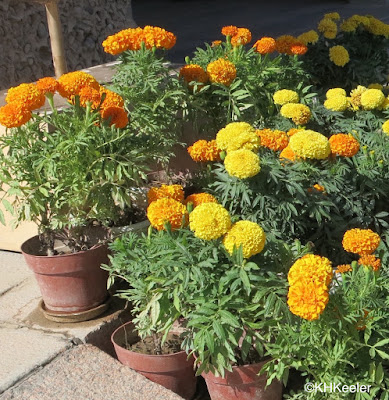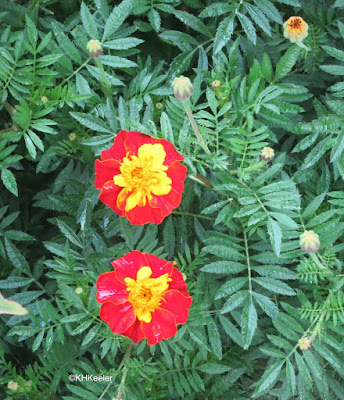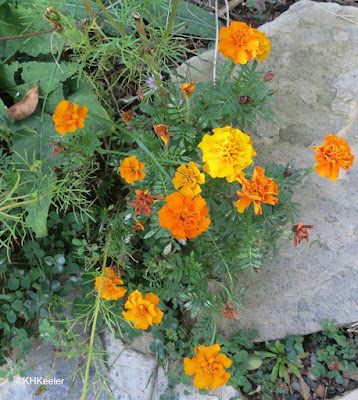 |
| marigolds, Tagetes |
Marigolds, Tagetes, were not wildflowers when they were brought to Europe (by 1520). The Aztecs and other Native American groups had been growing them for centuries.
There are some 57 species of Tagetes native to the Americas. The name Tagetes was created by Linneaus, naming them for the Etruscan religious figure Tages.
(Botanical sources say Tages was an Etruscan god, son of Jupiter. Sources on the web about the Etruscans say he was a human prophet with magical powers (link). How do I reconcile this? Well, perhaps Linneaus didn't have good information about Tages when he chose the name and got the story wrong. The internet gives us amazing power to look things up! My plant books all say Tages was an Etruscan god, son of Jupiter, who sprang full-grown from a plowed field. I don't own any books on the Etruscans so nothing in my print library contradicts that. But now I can find all kinds of ancient history sites on the web and get quite different information. Which finds contradictions but doesn't explain them.)
Marigolds are mostly herbaceous plants--a few are shrubs--with yellow to orange flowers and a distinctive, spicy smell. The African (or Aztec) marigold Tagetes erecta, the French marigold, T. patula and the signet marigold T. tenuifolia are the most widely grown species.
These three species and others such as Mexican tarragon (Tagetes lucida) were grown by the Aztecs in Mexico and Guatemala and the Mayans before them. The plants were used ceremonially and medicinally. It is not clear if marigolds were eaten much. The Europeans who recorded plant uses in the 1500s focused on medicinal plants. Certainly marigolds weren't major crops like corn and squash. That marigolds were not common foods is reflected in Aztec gardens. The Aztec emperor and his high nobles owned elaborate gardens of only nonfood plants: growing food was for peasants. The imperial gardens were incredible show places of sacred and rare plants and at least some marigolds were grown in those gardens.
Tagetes erecta has been called the African marigold because it was taken to Africa from Mexico, where the plants escaped to become roadside weeds. In 1535, when the Holy Roman Emperor Charles V led an expedition against the Barbary pirates in Algeria, he found fields blooming in marigolds. He called them Flos Africanus and brought them back to Europe, hence the name African marigold. (photos online) Modern sources prefer to call them Aztec marigolds. (However, all the common marigolds are Aztec plants.)
 |
| Aftrican marigold or Aztec marigold, Tagetes erecta |
(Online sources give the goddess of the underworld, Mictlantecuhtli, as presiding at the Day of the Dead, but my understanding is that the Aztecs had a complex route to the afterlife. Warriors and women who died in childbirth went the most directly to a pleasant afterlife, so Cihualcoatl-Quilaztli was very involved in celebrating the honored dead.)
Also from the Aztecs came Tagetes patula, with red-and-gold flowers. It was introduced first to France (likely from Spain) and went from there to England, so the English called it the French marigold. (pictures online) (link) The species epithet patula means jeweled. The French marigold is often red and yellow. That original variety, building on its sacred status from the Aztecs as a marigold, led to people across Central America to see it as a symbol of the slaughter of the native people by the Spanish invaders: the yellow represents the people, the red the blood spilled.
 |
| Marigold as symbol of the slaughter of native Central Americans by invading Europeans |
The third species frequently found in cultivation is Tagetes tenuifolia, the signet marigold or golden marigold (online photos).
 |
| Tagetes tenuifolia, signet marigold |
Another sacred Aztec marigold was yyauhtli, "cloud plant," and used ceremonially, as incense, and as a medicinal. Some of my sources identify it as Tagetes erecta, more recent ones as T. lucida. Its identity is a guess since the information about yyauhtli appears in the Aztec herbal of 1552 (See samples of illustrations from 1552 link and think about trying to name those plants). It is agreed to be one of those two plants and not some other. Medicinally the 1552 herbal recommends yyauhtli to remove ticks from the skin, to counter diarrhea and to stop the spitting of blood. Yyauhtli was combined with cypress and papalo-quilitl (Porophyllum viridiflorum, an aromatic Mexican marigold-like plant) in water, warmed and rubbed on the chest to cure hiccoughs. It was part of a complex treatment to cure someone struck by lightning (complete formula).
Yyauhtli also had what we would call magical powers: the Aztec herbal describes that, to safely cross a river or other body of water, an Aztec should moisten the chest with juice of yyauhtli and one of the papalo-quilitl species, crushed in water. Then he (or perhaps she) should take in his hands a beryl and the head and viscera of an oyster, and put into his mouth, but not eat, a sardonyx and the eyes of a large fish. So prepared, he could cross the water safely. While that sounds bizarre, tropical rivers had strong, unpredictable currents that could pull you under, hungry alligators, poisonous snakes, revolting leeches and aggressive fish such as piranhas, to name the risks I know of. Not something to do lightly.
Not cultivated but growing as a weed in the southeastern United States and California is Tagetes minuta, called muster John Henry, stinking roger and wild marigold. The flowers are small (hence the species epithet minuta "small" or "miniature") but the plant can be more than 6' tall. (photos). This plant is used to produce most of the tagetes oil made worldwide (link, link2). It is highly repellent to flies of all sorts (Diptera), and so widely used to repell insects, especially in Africa where it is a widespread weed. If cattle eat it, the milk and butter become very bitter.
Most information available to me on the marigolds outside the United States is from Mexico, but they grow all across Central America and deep into South America. The Aztec marigold, French marigold and muster John Henry all appear as medicinal herbs in the Amazon, used for treatments from eye washes to settling the stomach to driving out worms. Ethnobotanical works report these and other Tagetes species as traditional medicinals all across the Americas.
 |
| marigolds! |
Comments and corrections welcome.
References
Cleversley, K. 2002. Tagetes lucida - Marigolds entheology.com link
Duke, J. A. and R. Vasquez. 1994. Amazonian Ethnobotanical Dictionary. CRC Press, Boca Raton, Florida.
Gates, W. 1939. An Aztec herbal. The classic codex of 1552. The Mayan Society. Toronto, Ontario.
Graziera, P. 2001. Concept of the garden in pre-hispanic Mexico. Garden History. 29 (2): 185-213.
Moore, M. 1992. Los remedios. Traditional herbal remedies of the Southwest. Red Crane Books, Santa Fe, New Mexico.
Morehart, C.T., A. M. Peñaloza, C. S. Sánchez, E. McClung de Tapia and E. I. Morales. 2012. Human sacrifice during the epiclassic period in th northern basin of Mexico. Latin American Antiquity. 23 (4): 426-448.
Neher, R. T. 1968. The ethnobotany of Tagetes. Economic Botany. 22 (4): 317-325.
Kathy Keeler, A Wandering Botanist
More at awanderingbotanist.com

No comments:
Post a Comment